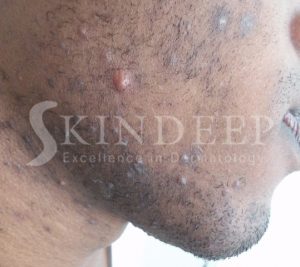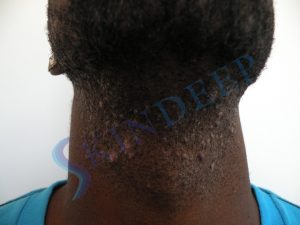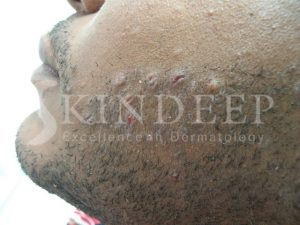PFB literally refers to a false inflammation of the hair folliculitis in the beard area. Most people prefer to call it razor bumps. The sharp cut end of curly hair penetrates the skin or sometimes a growing hair inside the skin gets lost and penetrates the follicular wall, to grow directly into the skin. An inflammatory foreign body reaction occurs around the embedded hair resulting in various clinical manifestations.

This disease of the beard usually affects male patients of colour but can potentially occur in any ethnic or racial population. Women with hirsutism can be affected as well due to the need to shave, pluck and use depilatory creams. Hirsutism is seen predominantly in women of Indian and black decent, women with a strong family history and cases of hormonal imbalance.

After shaving patients may experience an inflammatory acne type eruption. It takes 3-5 days for hair to grow long enough to pierce the skin. Initially a flesh coloured papule may form which becomes inflamed and red. Pustules, nodules and abscess formation can occur in severe cases. Scarring causes atrophy (depressions in the skin) or result in thickened scars or keloids. Dark patches can also be formed which are cosmetically unsightly.

The treatment of this condition depends on the severity, gender and previous treatments used. Of course growing a beard and giving up shaving is an option for male patients. Unfortunately some jobs do not allow the luxury of keeping a beard even if well groomed.
Individuals who need to shave should adopt an appropriate regime:
- The beard area should be cleaned with a mild soap, antiseptic soap, or surgical scrub utilising a swirling or circular motion using the hands, a soft cloth, buf-puf or a soft brush as tolerated. It is important to avoid bruising and irritation.
- Ingrown hair, which is visible at the surface, can be released using a toothpick or sterile needle while avoiding puncturing the skin.
- Avoid tweezing, plucking and squeezing lesions. Plucking distorts the hair follicle opening and contributes to ingrown hair within the skin.
- Shaving is best performed with a single blade razor or a machine, which leaves the hair just sticking out of the skin. One pass per area in the direction of hair growth without stretching the skin is the best method.
Exfoliating products like glycolic acid and tretinoin cream help to decrease embarbment of the hair into the skin. Topical antibiotic lotions containing clindamycin or erythromycin kill bacteria and reduce inflammatory changes. Other medications used for acne combining benzoyl peroxide and antibiotics exfoliate, kill bacteria and reduce inflammation as well and can be helpful. Severe cases of PFB resulting in the formation of nodules and abscesses with a risk of scarring may require oral antibiotics and intralesional steroids.

The Nd: Yag laser is the very efficient in the treatment of PFB. It can be used as a solution via permanent hair reduction. Interval treatment with this laser can also be used to treat flares of PFB as required in individuals who want to preserve their beard. Intense Pulse Light (IPL) is another method but there is a high incidence of pigment disorders as a side effect.
Female patients with familial or racial causes for PFB can be treated in a similar way. In cases where there are hormonal causes in the younger age groups contraceptives and other hormonal treatments can be used to reduce the size of the hair. Vaniqa cream is widely used by females to inhibit hair growth.
There is no need to allow PFB to ruin your appearance. See your dermatologist and get started on a solution.

